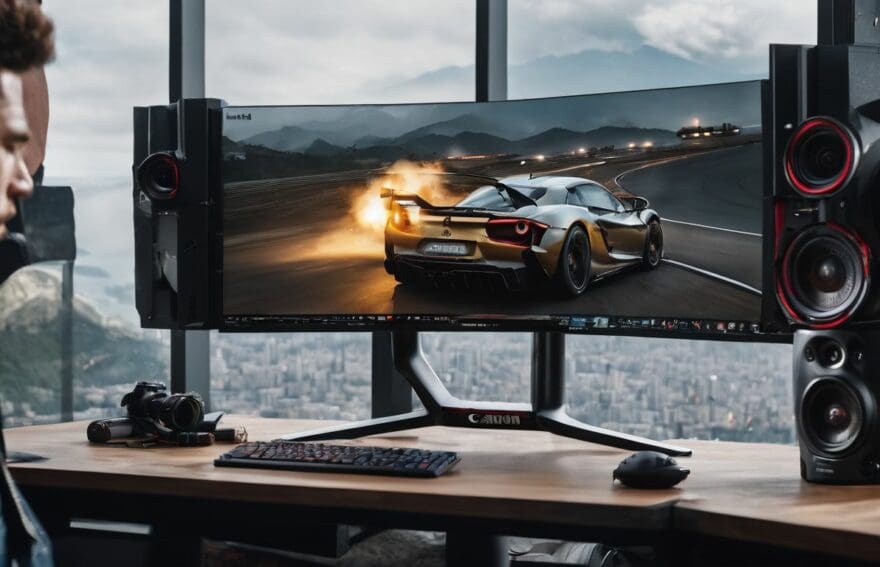240Hz vs. 144Hz Monitors: Is the Upgrade Worth It for Esports?

Updated On: November 13, 2025 by Aaron Connolly
As passionate gamers, we’re perpetually in pursuit of that flawlessly fluid and responsive gaming experience – it’s the ace up our sleeve that could tip the scales between triumph and defeat in the throbbing heart of esports.
We’ve all been at these crossroads, mulling over whether taking the leap from a 144Hz to a 240Hz monitor will truly sharpen our competitive edge. Fear not, for our comprehensive guide comes brimming with insights and expert analyses designed to navigate you through this tricky tech conundrum.
Plunge into our treasure trove of findings and figure out whether splashing out on that swift-as-a-whippet high-speed monitor is indeed your ticket to glory in the gaming arena!
Refresh Rates for Gaming: Understanding the Difference
Understanding the difference between refresh rates for gaming is crucial in determining whether an upgrade to a 240Hz monitor is worth it. From 60Hz to 120Hz to 144Hz and finally, 240Hz, each increase offers potential benefits for esports gamers seeking a competitive edge.
60Hz vs. 120Hz vs. 144Hz vs. 240Hz
When we consider the refresh rate spectrum in gaming monitors, options range from the standard 60Hz up to the ultra-smooth 240Hz. Each step up aims to deliver a more fluid visual experience, but the impact varies depending on the games we play and our sensitivity to screen fluidity.
| Refresh Rate | Experience | Best For | Hardware Demands |
|---|---|---|---|
| 60Hz | Standard smoothness sufficient for casual gaming. | Non-competitive gaming, general use. | Minimal, most systems can handle 60Hz. |
| 120Hz | Noticeably smoother than 60Hz, a good middle ground. | Intermediate gaming, emerging competitive players. | Moderate, needs more GPU power than 60Hz. |
| 144Hz | Smooth with responsive image, a favourite among gamers. | Competitive gaming, fast-paced action. | High, requires strong GPU for stable performance. |
| 240Hz | Ultra-smooth, peak performance for serious gamers. | Esports and high-level competitive gaming. | Very high, top-tier GPU needed for full potential. |
Higher refresh rates facilitate a smoother and more responsive connection to the game, which is vital for us in the esports realm. Upgrading from 144Hz to 240Hz can be a game-changer, but remember, such a leap demands a powerful rig to truly capitalise on the monitor’s capabilities. Cost can also be a deciding factor, and we must weigh our options carefully, considering our budget and the types of games we play. For some, the difference may not be immediately noticeable, but in high-stakes competitive gaming, every millisecond of responsiveness counts. It’s all about finding that sweet spot between performance gains and what we’re willing to invest in our gaming setup.
Potential Benefits of Higher Refresh Rates for Esports
For esports enthusiasts, the potential benefits of higher refresh rates are significant. The smooth gameplay and responsive display offered by 144Hz and 240Hz monitors create a competitive edge in fast-paced games, reducing motion blur and enhancing the overall gaming experience.
With a higher refresh rate, gamers can enjoy improved visual clarity, allowing for quicker reaction times and increased precision during intense gaming situations. This upgrade is particularly valuable for competitive players seeking to gain an advantage in high-stakes esports tournaments.
Gaming performance sees a substantial boost with high refresh rate monitors like 144Hz and 240Hz. The fluidity of motion provided by these displays elevates the level of play, providing a more immersive gaming experience that enhances responsiveness to on-screen action.
Debunking Common Myths about 240Hz Monitors
Many gamers believe that 240Hz monitors are overkill for Esports, but we’ll debunk this and explore whether the upgrade is worth it. We’ll also address whether the difference between 144Hz and 240Hz is noticeable in gaming performance.
Is 240Hz Overkill?
Upgrading to a 240Hz monitor may seem excessive, but for passionate and competitive gamers, the difference in smoothness and responsiveness can be noticeable. The jump from 144Hz to 240Hz might not be crucial for everyone, but in fast-paced esports games where split-second reactions matter, the higher refresh rate can give players a slight edge.
It’s important to consider individual gaming preferences and hardware capabilities before determining if the upgrade is worth it. Ultimately, while some users may not see a significant difference between 144Hz and 240Hz in everyday use, for those seeking the highest level of performance and responsiveness in their gaming experience, a 240Hz monitor could make a real difference.
Is 240Hz Noticeably Better than 144Hz?
The difference between 240Hz and 144Hz is noticeable to some gamers, while others may not perceive a significant improvement in smoothness and responsiveness. Gamers who play fast-paced esports titles or first-person shooters tend to appreciate the enhanced fluidity and reduced motion blur that comes with a 240Hz monitor.
However, whether this upgrade is worth it depends on individual perception, gaming preferences, and budget constraints. Testing out both refresh rates firsthand can provide valuable insight into the tangible benefits of 240Hz over 144Hz for competitive gaming scenarios.
The transition from a 144Hz to a 240Hz monitor may offer subtle advantages in terms of responsiveness and visual clarity during intense gameplay situations. Factors such as input lag reduction and smoother motion handling contribute to an overall improved gaming experience for some users.
Factors to Consider Before Upgrading to a 240Hz Monitor
When considering the upgrade to a 240Hz monitor for esports, it’s important to assess your computing requirements, as higher refresh rates may demand more powerful hardware. Cost analysis is also crucial, as 240Hz monitors can come with a higher price tag.
Additionally, take into account the visual enhancements that come with these monitors, such as HDRi and Black eQualizer technology.
Computing Requirements
240Hz monitors require powerful computing hardware to fully utilise their capabilities. Upgrading your system with a high-end graphics card and a robust processor is essential to achieve smooth gaming at such high frame rates.
The increased demands on your computer’s processing power means that you’ll need to ensure sufficient RAM and a fast SSD to keep up with the intense data transfer speeds required for competitive gaming.
It’s important to note that not all games will support 240Hz refresh rates, so checking compatibility with your favourite titles before investing in a monitor upgrade is crucial. Additionally, consider future-proofing your rig by ensuring it meets the recommended specifications for upcoming game releases.
Cost Analysis
When considering the cost of upgrading to a 240Hz monitor, it’s essential to factor in not only the price of the monitor itself but also the potential expenses associated with upgrading other gaming hardware. For instance, to fully utilise the capabilities of a 240Hz monitor, you may need a high-performance graphics card and processor, which could add significant costs to your upgrade. Additionally, if investing in visual enhancements like HDRi or Black eQualizer is important for enhancing your esports gaming experience, these factors should be considered when evaluating whether the upgrade is worth it.
It’s crucial for passionate and novice gamers alike to weigh this cost against potential benefits such as improved responsiveness and enhanced smoothness during gameplay. Ultimately, carefully assessing individual budget constraints and specific gaming needs will help determine whether investing in a 240Hz monitor aligns with one’s priorities for optimising their esports performance.
Visual Enhancements (HDRi, Black eQualizer, 2.1 Channel Audio)
240Hz monitors often come with additional visual enhancements to elevate the gaming experience. These features are designed to provide competitive gamers with an edge and enhance the overall gameplay. Below are some of the essential visual enhancements commonly found in 240Hz monitors:
- HDRi (High Dynamic Range Imaging) technology delivers improved contrast, brightness, and colour accuracy, resulting in more vibrant and realistic visuals.
- Black eQualizer technology enhances visibility in dark scenes without overexposing brighter areas, giving players an advantage in spotting opponents lurking in the shadows.
- 2.1 Channel Audio provides immersive sound quality with distinct audio channels for better spatial awareness, allowing gamers to accurately locate in-game cues like footsteps and gunfire.
The Verdict: Is the Upgrade to a 240Hz Monitor Worth It for Esports?
Upgrading to a 240Hz monitor for esports can significantly enhance the gaming experience, offering smoother and more responsive visuals during fast-paced gameplay. With its higher refresh rate, a 240Hz monitor delivers improved clarity and reduced motion blur, providing an edge in competitive gaming scenarios.
The enhanced responsiveness and fluidity of motion in games can lead to quicker reaction times, ultimately impacting performance. While some users may not perceive a stark difference between 144Hz and 240Hz displays in everyday use, passionate gamers seeking the highest level of performance and responsiveness in their gaming experience may find that the upgrade is worthwhile.
Considering factors such as individual preferences, budget, hardware requirements, and specific gaming needs is crucial when determining whether the upgrade to a 240Hz monitor is suitable.
For dedicated esports players or those who seek every advantage when competing at a high level, investing in a 240Hz monitor could provide noticeable benefits. Ultimately, exploring firsthand experience with a 240Hz display before making a decision to upgrade will allow users to gauge the tangible improvements it offers for their particular gaming style.
Recommended 240Hz Monitors for Esports
Considering the potential benefits of upgrading to a 240Hz monitor, here are some recommended options for passionate gamers looking to enhance their esports experience:
- ASUS ROG Swift PG259QN: Known for its ultra-fast refresh rate and NVIDIA G-SYNC technology, providing smooth gameplay and responsive visuals ideal for competitive gaming.
- Alienware AW2521HFL: Featuring a high refresh rate and fast response time, this monitor offers enhanced visual clarity and fluid motion for an immersive gaming experience.
- BenQ ZOWIE XL2740: Designed specifically for esports with customisable display settings, Black eQualizer technology, and competitive edge features for precise control in fast-paced games.
Conclusion
In conclusion, deciding whether to upgrade to a 240Hz monitor for esports depends on individual preferences and gaming needs. The upgrade can provide smoother, more responsive gameplay in competitive scenarios.
It’s crucial to consider factors such as hardware requirements, budget, and personal experience before making the decision. Testing out a 240Hz monitor firsthand is recommended to gauge its impact on your gaming experience.
Ultimately, the choice of upgrading from 144Hz to 240Hz will vary based on individual perceptions and specific gaming usage.
FAQs
1. What difference will I notice if I switch from a 144Hz to a 240Hz monitor for esports?
Upgrading to a 240Hz monitor from a 144Hz display offers a smoother gaming experience, which can be particularly beneficial in competitive gaming scenarios.
2. Is it worth upgrading my monitor for better performance in esports?
Yes, getting a higher refresh rate like the one provided by 240Hz monitors can enhance your gaming hardware and potentially give you an edge in fast-paced competitive games.
3. Do all gamers need to upgrade their monitors to enjoy games?
Not necessarily; while serious esports players may benefit from monitor upgrades such as moving from 144Hz to 240Hz displays, casual gamers might find their current setup sufficient.
4. How does display technology affect my gaming experience?
The technology behind your display plays a crucial role – for instance, higher refresh rates like those offered by competitive gaming monitors can lead to more fluid visuals and sharper responses during gameplay.


